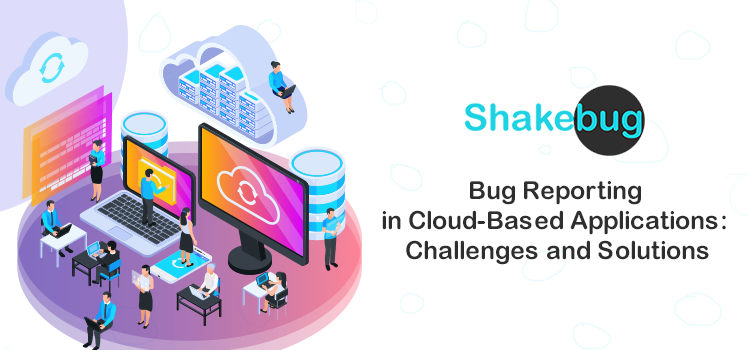Bug Reporting Challenges in Cloud-Based Applications
Bug reporting is an important part of software development, especially in cloud-based applications. With the increasing complexity and interconnectedness of these systems, bug reports can be difficult to track down and fix. As a result, developers must take extra care when dealing with bug reports for their cloud-based applications.
This includes an understanding of the types of bugs, how bugs are reported, what tools are available to help identify them quickly, and how best to communicate with users about any issues they may encounter.
1. Scalability and Performance Issues
Bug reporting can be a challenge for cloud-based applications due to scalability and performance issues. As the number of users increases, so does the complexity of bug reports that need to be addressed. This makes it difficult for developers to identify and fix bugs on time.
Additionally, since these applications are hosted on remote servers, there is often an increased risk of data loss or corruption which can further complicate debugging efforts.
2. Data Security and Privacy Concerns
Bug reporting in cloud-based applications can be challenging due to data security and privacy concerns. Cloud computing is a relatively new technology, so there are still many unknowns when it comes to the safety of user information stored on the cloud. Companies must ensure that all customer data remains secure while also ensuring compliance with relevant regulations such as GDPR or HIPAA.
3. Integration and Compatibility Problems
Bug reporting challenges in cloud-based applications are becoming increasingly common. One of the most significant issues is integration and compatibility problems, which can arise when different components within a system don’t work together as expected.
This can lead to unexpected errors or bugs that need to be addressed quickly before they cause further damage. It’s important for developers to thoroughly test their code before deployment so any potential issues can be identified early on and rectified accordingly.
Best Practices for Bug Reporting in Cloud-Based Applications
Bug reporting is an important part of the development process for cloud-based applications. It helps developers identify and fix issues quickly, ensuring that users have a good experience with their applications. Below given are some best practices for bug reporting in cloud-based applications to help ensure that bugs are reported accurately and efficiently.
1. Clear and Reproducible Bug Descriptions
Best Practices for Bug Reporting in Cloud-Based Applications include providing clear and reproducible bug descriptions. This means that when reporting a bug, it should be described as accurately and concisely as possible so that developers can understand the issue quickly.
Additionally, any steps taken to reproduce the bug should also be included in the report.
2. Capturing and Sharing Relevant Logs and Error Messages
Capturing and sharing relevant logs and error messages is one of the best practices for bug reporting in cloud-based applications. Logs can provide valuable information about what went wrong, such as when an application crashed or a user experienced unexpected behaviour.
Error messages are also important to capture because they often contain detailed descriptions of why something failed or didn’t work correctly. By capturing these logs and error messages, developers can quickly identify the source of any issue that arises with their application. This helps them fix bugs faster and improve overall performance.
3. Prioritizing Bugs and Collaboration with Development Teams
When it comes to bug reporting in cloud-based applications, one of the best practices is prioritizing bugs and collaborating with development teams. This means that when a bug report is submitted, it should be assigned an appropriate priority level based on its severity and impact.
Additionally, developers need to collaborate with other members of the team such as product managers or testers to ensure that all issues are addressed quickly and efficiently. By following these steps, organizations can ensure their cloud-based applications remain secure and reliable for users.
Related Read:- Best Practices for Working with Remote Teams in Bug Reporting
Bug Reporting Tools and Techniques for Cloud-Based Applications
Bug reporting tools and techniques are essential for cloud-based applications. With the increasing popularity of cloud computing, it is important to have a reliable bug-reporting system in place that can quickly identify issues with an application or service.
Below we will discuss different bug reporting tool and techniques available for use on cloud-based applications and how they can be used effectively.
1. Automated Bug Tracking and Reporting Tools
Automated bug tracking and reporting tools can help to identify, track, report, and resolve issues quickly and accurately. These tools provide a comprehensive view of application performance in real-time so that developers can address any potential problems before they become major issues.
They also allow users to submit feedback on their experiences with an application which helps developers improve user experience over time. With automated bug tracking and reporting tools, businesses have more control over how their applications perform while ensuring customer satisfaction at all times.
2. Cloud-Specific Bug Reporting Platforms
Bug reporting tools and techniques for cloud-based applications have become increasingly important in recent years. One of the most popular bug-reporting platforms specifically designed for cloud-based applications is CloudBugs, which provides users with an easy-to-use platform that allows them to report bugs quickly and accurately. It also offers a range of features such as automated testing, detailed reports, and real-time notifications when new issues are found.
3. Leveraging User Feedback for Bug Reporting
Leveraging user feedback for bug reporting is an important tool and technique when it comes to cloud-based applications. This type of bug reporting allows users to provide detailed information about the issue they are experiencing, allowing developers to quickly identify and address any issues that may be present in their applications.
By leveraging user feedback, developers can also gain insight into how customers interact with their product or service, which can help them improve future versions of the software. Additionally, this method helps ensure that bugs are addressed as soon as possible so that customer satisfaction remains high.
Strategies for Effective Bug Triage and Resolution in Cloud-Based Applications
Bug triage involves identifying, categorizing, prioritizing, and resolving bugs that are discovered during testing or production. Implementing an efficient process to track, prioritise, and resolve these issues quickly and accurately can help improve customer experience as well as reduce costs associated with fixing them.
Additionally, having clear communication between developers and testers will ensure that all stakeholders have visibility into the progress of each issue so they can make informed decisions about how best to proceed with its resolution.
1. Setting Severity and Priority Levels
When it comes to bug triage and resolution in cloud-based applications, setting severity and priority levels is a crucial strategy. This involves assessing the impact of each bug on user experience or system performance, as well as how quickly they need to be addressed.
By assigning appropriate severity and priority levels for each issue, teams can ensure that bugs are fixed efficiently with minimal disruption. Additionally, this helps prioritize tasks so that developers know which issues should take precedence over others.
2. Efficient Bug Triage and Assignment Processes
One of the most important strategies is an efficient bug triage and assignment process. This involves identifying potential bugs as soon as they occur, assigning them to a team member or group responsible for resolving them, tracking progress on each issue, and ensuring timely resolution.
Establishing clear protocols for this process can help streamline the entire development cycle by reducing time spent troubleshooting problems while also improving customer satisfaction with faster resolutions.
3. Monitoring Bug Fixes and Verification
When it comes to strategies for effective bug triage and resolution in cloud-based applications, monitoring bug fixes and verification is a key step. This involves keeping track of the bugs that have been fixed as well as verifying that they are indeed resolved. It also includes tracking any new issues or regressions that may arise after the fix has been implemented.
Monitoring these changes can help ensure that all problems are addressed quickly and effectively, allowing businesses to maintain high levels of quality assurance in their products.
Improving Communication and Collaboration in Cloud-Based Bug Reporting
Cloud-based bug reporting has become increasingly popular in recent years, as it allows for easier communication and collaboration between teams. This type of system can improve the efficiency of bug tracking by providing a centralized platform where all members have access to the same information.
Additionally, cloud-based bug reporting systems allow for real-time updates on bugs and provide better visibility into the progress being made towards resolution. By improving communication and collaboration through cloud-based bug reporting, organizations can quickly identify issues and resolve them more efficiently than ever before.
1. Establishing Clear Channels of Communication
Establishing clear channels of communication is essential for improving collaboration and communication in cloud-based bug reporting. This includes having a well-defined process that outlines how to report bugs, who should be involved when doing so, and what the expected response time will be.
Additionally, it’s important to ensure there are multiple ways for developers to communicate with each other such as email, chat platforms or video conferencing tools. By establishing these clear channels of communication early on, teams can work together more effectively and efficiently when dealing with any issues related to bug reports.
2. Encouraging Feedback and User Participation
Improving communication and collaboration in cloud-based bug reporting is an important step for any organization. One way to do this is by encouraging feedback and user participation. This can be done through surveys, forums, or other methods of gathering information from users about their experience with the product. By collecting data on how users interact with a product, organizations can make more informed decisions when it comes to fixing bugs or improving features.
3. Collaborative Bug Reporting Workflows
Improving communication and collaboration in cloud-based bug reporting is an important step for businesses to take. One way of doing this is through collaborative bug-reporting workflows, which allow multiple people to collaborate on the same issue at once. This can help speed up the process of resolving bugs by allowing different team members to contribute their expertise and ideas simultaneously.
Additionally, it helps ensure that all stakeholders are kept informed throughout the entire process so everyone knows what’s going on with any given project or task.
Conclusion
Bug reporting in cloud-based applications is an important part of the development process. It helps to identify and fix bugs quickly so that users can have a better experience with the application. With proper tools and processes in place, developers can ensure that their applications are free from any kind of errors or issues which may disrupt end users. Bug reporting should be done regularly to keep track of any changes made to the codebase as well as new features added over time.


